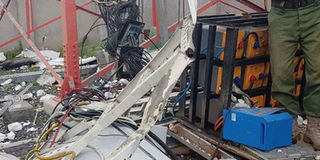Learning in northern Kenya faces crisis after terror attacks

The Safaricom communication mast which was destroyed by suspected Al-Shabaab in Garissa on January 7, 2020. The terror attacks in northern Kenya are threatening to cripple learning in the region. PHOTO | BRUHAN MAKONG | NATION MEDIA GROUP
What you need to know:
- On Monday, three teachers were killed when suspected Al-Shabaab militants attacked Kamuthe in Garissa.
- Mr Robert Kivuti said that he ran for his life towards the bush after hearing gunshots.
- Four pupils lost their lives when suspected militants staged a dawn attack at Saretho Primary School in Dadaab.
Kenya’s northern region is staring at yet another education crisis as attacks by the militant Al-Shabaab group intensify in the counties bordering Somalia.
Over the last five weeks alone, the Somalia-based militants have carried out more than 10 attacks both in northern and coastal Kenya, which have left at least 25 people dead.
On Monday, three teachers were killed when suspected Al-Shabaab militants attacked Kamuthe, Garissa County, the second terror incident in a week.
PANIC
The attack, which happened around 2.30am, has left teachers in the region in panic as they expressed fear for their lives.
The militants are said to have spared female teachers and a nurse during the attack.
After the incident, several teachers who survived the attack narrated how they narrowly escaped death in the hands of the militants.
Mr Robert Kivuti said that he ran for his dear life towards the bush after hearing gunshots and was pursued by two attackers for close to 100 metres before they gave up on him.
Another survivor, Ann Gideon, said that she heard one of the attackers speaking in Swahili, telling his counterparts to ensure that no one is left alive, before proceeding to a house where men were executed.
Lucy Wanjiru, another teacher who had a young child at the time of the attack, said she had to hide under a bed. She said the incident was highly traumatising.
PUPILS KILLED
Just a week ago, four pupils lost their lives when suspected militants staged a dawn attack at Saretho Primary School in Dadaab Sub-County.
The attack also left three pupils and an officer with injuries.
The attackers have also left a trail of destruction. They have destroyed communication masts and targeted police camps on both occasions.
The two incidents, which have attracted harsh condemnation from leaders, are likely to deal a major blow to the already struggling education sector in the region.
A number of teachers have already begun leaving the area in fear of more attacks despite assurances from security agencies.
On Tuesday, it emerged that a section of teachers in Mandera County are living in fear after their Garissa counterparts were murdered.
Two years ago, a mass exodus of teachers was witnessed in the region after Shabaab insurgents attacked Qarsa Primary School in Wajir County and killed three people including two teachers.
URGENT MEETING
On Monday, Kenya National Union of Teachers (Knut) Secretary-General Wilson Sossion called on Education Cabinet Secretary George Magoha to convene an urgent meeting to discuss the security of teachers after the recent attacks.
"Before we urge teachers to move out, can we have an urgent meeting? Every time we raise this issue, we have never had the ministry or TSC convening a meeting. It has been a cat and mouse game which has seen teachers vacate," said Mr Sossion.
Knut further said that failure to address the issue by the Education ministry will force them to ask teachers who feel insecure to leave the areas immediately for the sake of their lives.
TRANSFERS
After the February 2018 incident, Knut made good its threat and hundreds of teachers left the northern region.
In Wajir County alone, TSC transferred at least 900 teachers to other parts of the country, a move which almost crippled the education sector in the county.
Some teachers from Garissa and Mandera were also transferred.
At least 250 schools were forced to close due to lack of teachers and those that remained open were run by headteachers and a few other teachers.
A similar move was also witnessed in 2014 when Al-Shabaab militants ambushed a Nairobi-bound bus in Mandera, killing 28 passengers, most of whom were teachers.
LAGGING BEHIND
Since then, and despite significant progress in the education sector, counties in the north have lagged behind and this has been blamed on lack of adequate teachers, harsh climatic conditions and terrorism.
This is not likely to change any time soon if the recent attacks are anything to go by.
Residents have already expressed fears that new mass transfers could happen.
In a region that mostly depends on teachers from other parts of the country, another exit could spell doom to learners who are now staring at a bleak future.
Mr Hussein Ali, a resident of Wajir whose six children are in school, told the Nation that another transfer of teachers from the region will be catastrophic.
“I am really worried about my children’s future. It will really be bad for us parents if our teachers leave again,'' he said.
PROTECT TEACHERS
He urged the Education ministry to come up with a security strategy to protect the teachers, saying the few elements causing insecurity should not be the reason to transfer the teachers.
Garissa County Education Director Yusuf Karayu told the Nation that they are consulting with TSC on the way forward after the attacks.
Despite the recent attacks, teachers and civil servants have been assured of their safety.
North Eastern Regional Coordinator Nicodemus Musyoki Ndalana told journalists on Monday that the security team has come up with a number of strategies to minimise the attacks.
"I am told some schools have closed and others are planning to close but let me assure the residents and Kenyans that the government has put good plans in place to make sure we deal with this problem," he said.




